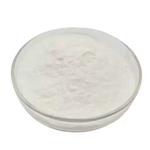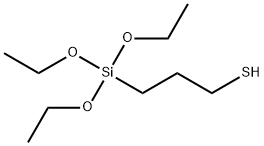3-Mercaptopropyltriethoxysilane: Role in Polyorganosiloxane Nanoparticles and SBR Reinforcement
3-Mercaptopropyltriethoxysilane (MPTMS) is commonly used in surface modification of silica nanoparticles by creating thiol group on the surface. It can be used as a reagent to prepare thiol functionalized materials. Silica, SBA-15, alumina, starch, and graphene can be functionalized with MPTS and used in various applications. 3-Mercaptopropyltriethoxysilane functionalized SBA-15 probe is used to determine dissolved mercury in solution.

Polyorganosiloxane nanoparticles from 3-Mercaptopropyltriethoxysilane
In recent decades, most composite materials used in polymer industry contain special resins based on dimethacrylates. Bisphenol A glycerolate dimethacrylate is one of the commonly used dimethacrylate monomers with reinforcing fillers as an epoxy dimethacrylate. The combination of the epoxy resins and methacyrlates has a major effect in polymerization systems due to the contribution of unique abilities of each. Moreover, their chemical structure includes unsaturated bonds which make them suitable for UV curing technology with radical photoinitiators. This article presents the synthesis of polyorganosiloxane nanoparticles with 3-Mercaptopropyltriethoxysilane (MPTMS) and the preparation of nanocomposite films with these nanoparticles via the photoinitiated thiol-ene polymerization reaction. Although there are very few articles reported on the application of silica nanoparticles in photopolymerized thiol-ene systems up to date, not enough attention is paid to this field. Still, despite all these works, the use of 3-Mercaptopropyltriethoxysilane modified silica nanoparticles in a thiol-ene acrylate formulation that contains a difunctional epoxy dimethacrylate: bisphenol A glycerolate dimethacrylate (Bis-GMA) and an 3-arm thiol acrylate: trimethylolpropane tris(3-mercaptopropionate) (TMPMP) has not been adequately studied.[1]
Silica nanoparticles with thiol groups (SiO2-3-Mercaptopropyltriethoxysilane) were synthesized with (3-mercaptopropyl) trimethoxysilane (as shown in Scheme 1) and characterized by determining particle size distribution and morphology using DLS and STEM. Figure 1 shows that SiO2-MPTMS nanoparticles were almost spherical in nanometric size of about 200 nm. The SiO2-MPTMS nanoparticles were successfully synthesized by a convenient condensation reaction. These nanoparticles were characterized by DLS, STEM, FTIR, and XPS, revealing the size and size distribution, morphology, and functional groups on the surface. The TGA results showed that the grafting ratio of thiol groups was 22.9% pointing to the successful modification process. A series of nanocomposite films were prepared by photoinitiated thiol-ene polymerization of an equimolar TMPMP: bis-GMA. The modulus and tensile strength of nanocomposite films increased as the amount of particles in the polymer matrix increased up to 2.5 wt %. Both STEM and SEM studies showed that the particle sizes of SiO2-3-Mercaptopropyltriethoxysilane were in the nanoscale. The MPTMS-modified nanoparticles are promising candidates for thiol-ene matrix as a nanofiller.
Effect of 3-Mercaptopropyltriethoxysilane Modified Illite on the Reinforcement of SBR
Rubbers with high elasticity play an irreplaceable role in various fields. However, the application of rubbers must be reinforced with filler to enhance their mechanical strength. Carbon black and silica are the two most widely used reinforcing fillers for rubber. However, their energy requirements in the manufacturing process are high. The modification of illite by CTAB enhances the interfacial interaction of it with NR and thus improves the properties of NR. Also, the capability of illite, either modified by 3-mercaptopropyltriethoxysilane (KH580) or bis[3-(triethoxysilyl)propyl] tetrasulfide (Si69), as a substitute filler for reinforcing of styrene butadiene rubber (SBR), has been investigated and the KH580 was proved to have a better modification effect on illite than Si69, which is the most widely used silane coupling agent in rubber industry. Therefore, the effect of illite particle size on the interface as well as the properties of 3-Mercaptopropyltriethoxysilane-modified illite/SBR composites was further illustrated in this work. It is found that the modification of illite by KH580 increases the K-illite/SBR interaction, and thus improves the dispersion of K-illite in the SBR matrix. Combined with the smaller size, the better dispersion of K-illite with stronger interfacial interaction improves the mechanical properties of SBR significantly. This work may pave the way for expanding the use of illite in the rubber industry.[2]
In summary, the reinforcement effect of naturally-occurring and low-carbon illite with different particle sizes and their 3-Mercaptopropyltriethoxysilane modified counterpart K-illite as fillers for SBR were studied. The results are as follows. (1) The mechanical properties of SBR can be improved both by raw illite and modified K-illite. The better reinforcement of K-illite than illite toward SBR is observed and confirmed to be attributed to the enhanced interaction of K-illite with SBR chains through chemical bonding, which also promotes the dispersion of K-illite in the SBR matrix. (2) The interfacial interaction and mechanical properties increase with reduction of particle size owing to increased specific surface area. (3) The K-illite-4/SBR composite has the best performances, whose tensile strength, tear strength and modulus at 300% are 16.7 MPa, 35.3 kN/m and 12.97 MPa, respectively.
References
[1]Karaca N. The synthesis and characterization of polyorganosiloxane nanoparticles from 3-mercaptopropyltrimethoxysilane for preparation of nanocomposite films via photoinitiated thiol-ene polymerization. Turk J Chem. 2021 Jun 30;45(3):761-774. doi: 10.3906/kim-2012-48. PMID: 34385866; PMCID: PMC8326481.
[2]Wang Z, Zhang H, Liu Q, Wang S, Yan S. Effect of 3-Mercaptopropyltriethoxysilane Modified Illite on the Reinforcement of SBR. Materials (Basel). 2022 May 11;15(10):3459. doi: 10.3390/ma15103459. PMID: 35629487; PMCID: PMC9143291.
You may like
See also
Lastest Price from 3-Mercaptopropyltriethoxysilane manufacturers

US $0.00-0.00/g2025-06-17
- CAS:
- 14814-09-6
- Min. Order:
- 0.1g
- Purity:
- 99.99%
- Supply Ability:
- 200000kg

US $10.00/KG2025-04-21
- CAS:
- 14814-09-6
- Min. Order:
- 1KG
- Purity:
- 99%
- Supply Ability:
- 100 mt


